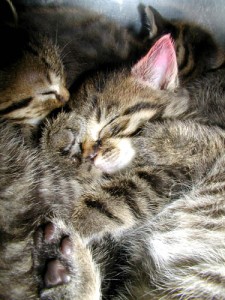Unfortunately, there are lots of games that marketers can play with words that have meaning… but that meaning may not be what you think it is. My hope with this post is to give you the knowledge to know what you’re looking at when you read the back of a pet food bag, and to make your decisions based on actual information, not fancy packaging.
So, some quick definitions. AAFCO, the Association of American Feed Control Officials, is in charge of monitoring pet food manufacturing. They have constructed some very specific definitions. For example, did you know that a food marketed as “beef dinner” is a very different food than one marketed as “with beef” or as “beef flavor”? Who knew, right?
A food that is labeled, for example, “Beef for dogs” must contain 95% beef not counting water for processing, and 70% beef including that water. Only the named meat counts toward the percentage. You can’t have a food labeled “Beef for dogs” that is made up of a large portion of, say, chicken.
However,
if the label reads “Beef dinner” (or entree or platter or formula, etc), then there only needs to be >25% of that ingredient. There’s an awful lot of room between 25% and 95%. And more interestingly, the named ingredient (“beef” in this case) does not even need to be at the top of the ingredients list). And if they want to make it, say, “chicken and fish entree for cats”, the chicken and fish must only add up to >25% in combination and there only need be 3% minimum of any single named ingredient. So your “chicken and fish entree” might only be 3% fish.
And there can be more and different ingredients that are not highlighted in the food’s name.
This can be a problem if your dog has a food sensitivity. Someone has suggested that you try a lamb and rice formula dog food for your pup because he seems to have a sensitive tummy. Lamb and rice can be good for some dogs with possible food sensitivities, so you scan the shelves and pull down a bag of Pro Plan Puppy Lamb and Rice. The front of the bag looks inviting. It’s Lamb and Rice formula, “Lamb is the first ingredient”. And it is, but as we learned in our previous food post, ingredients are listed by weight, and when you take the water weight out of a fresh, unprocessed meat, it tends to drop way down on the list. Where’s the real source of protein in this food coming from? Poultry by-product meal (chicken? turkey? duck? who knows!). So much for avoiding ingredients your dog might be sensitive to.
(If your dog doesn’t have issues with specific ingredients, this is much less of a concern!)
It’s frustrating. You shouldn’t need a PhD to read food labels.
In contrast, look at this food: Nature’s Variety Instinct Lamb Meal and Peas. The first ingredient? Lamb meal. Top of the list, no other hidden meats. Fairly transparent. And yes, more expensive, right?
Did you know that “with” also has a legal definition? “With” means there is between 3% and 25% of that ingredient in the food. It was designed as a way to highlight minor ingredients mostly for marketing purposes. Chicken dinner WITH cheese, for example.
And then at the bottom of the list comes “flavor”. “Bacon flavor dog biscuits” need only contain enough of that ingredient to be detectable.
(I am not sure who does the detecting.)
It seems the further you look, the more confusing it gets.
Recently the trend seems to be toward “Natural” and “Holistic” foods. The ads on television want you to believe that Holistic is better for your pet.
But what is “Holistic”? As far as pet food goes, there is no real (legal) definition.
“All Natural” is a funny one. It means that the ingredients must be “derived solely from plant, animal or mined sources” but can be put through any manufacturing process that the company wants it to as long as they don’t add anything synthetic to it… except for that which is unavoidable for processing. Clear as mud, right?
The same thing with “Human Grade”, which AAFCO considers a “false and misleading” phrase, as all ingredients would have to meet both requirements from the USDA for pet food and the FDA for human food. Technically it’s possible, but it’s unlikely that many pet food processing plants actually meet the grade.
Organic is even more confusing. There is no organic certification for pet food ingredients (and thus no official seal from the National Organic Program which certifies human organic foods), and yet AAFCO allows the word to be used on packaging and nobody’s really going to make a fuss about it. So what’s a word worth? Who knows.
I think the best we can do is look with open eyes and let our minds be reasonable. We all want what’s best for our pets, right? But does “best” have to equate with “super fancy high end organic”? Is it worth paying for labeling that uses terms that don’t really mean anything?






